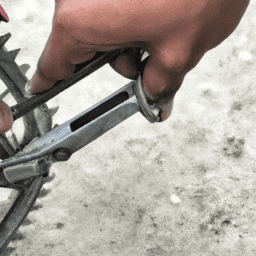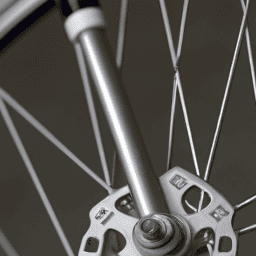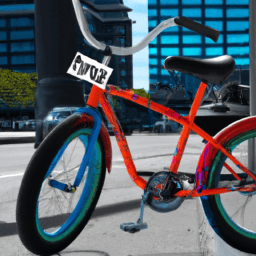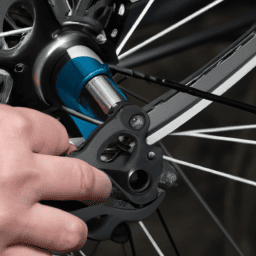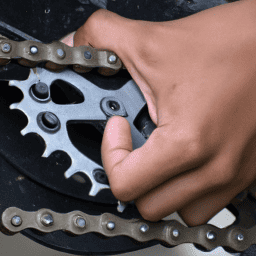For those who love cycling, understanding that proper tire pressure is key for a seamless and secure journey is essential. No matter if you’re pedaling to the office, navigating challenging mountain paths, or gliding on a hybrid bicycle, the amount of air in your tires significantly impacts how well you ride.
But with so many different types of bikes and tires out there, it can be tough to know exactly how much pressure you should be using.
In this article, we’ll dive into the world of tire pressure and help you understand how to find the right level for your bike. We’ll explore the ideal pressure ranges for road bikes, mountain bikes, and hybrid bikes, and we’ll give you tips on how to check and adjust your tire pressure to ensure a smooth and safe ride every time.
So whether you’re a seasoned cyclist or just starting out, read on to learn everything you need to know about tire pressure for your bike.
Key Takeaways
- Tire pressure is crucial for optimal bike performance and safety.
- Different types of bikes and tires require different pressure levels.
- Recommended tire pressure ranges can be found on the tire’s side and should be adjusted regularly.
- Regular maintenance is crucial for maximizing bike performance, preventing potential problems, and extending bike lifespan.
Understanding Tire Pressure
You’ll need to understand tire pressure if you want to keep your bike running smoothly. Tire pressure is the amount of air inside a tire, and it’s important to maintain the correct pressure for optimal performance.
There are various measuring techniques to determine the tire pressure, including using a pressure gauge or checking the tire’s sidewall markings.
It’s also important to consider the effects of temperature on tire pressure. As the temperature changes, the air inside the tire expands or contracts, leading to changes in pressure. Therefore, it’s essential to check the tire pressure regularly and adjust it accordingly, especially if you’re riding in extreme temperatures.
With proper tire pressure, you can enhance your riding experience and avoid damage to your bike. Road bikes, in particular, require specific tire pressures for optimal performance on the road.
Road Bikes
If you’re a road cyclist, riding on smooth, paved roads is the norm and you’ll want a bike that is designed for speed and agility. For example, if you’re participating in a local race, you might opt for a lightweight road bike with aerodynamic wheels to help you slice through the wind and maintain your pace. When selecting a road bike, consider the type of riding you’ll be doing and your personal preferences. Road bikes come in a variety of styles, including endurance, racing, and aero, each with its own unique features and benefits.
Cycling aerodynamics is crucial for road cyclists, as even small changes in wind resistance can make a big difference in overall speed and performance. The table below highlights some key considerations when selecting a road bike, including frame material, wheel type, and weight. Keep in mind that while a lightweight bike may be faster on flat terrain, a heavier bike may be more stable and easier to handle on descents and in windy conditions. When selecting your road bike, be sure to do your research and test ride several options to find the one that best fits your needs and riding style. Moving on to mountain bikes, the terrain and riding conditions are vastly different, requiring a different type of bike and tire pressure.
Mountain Bikes
When it comes to mountain bikes, ideal tire pressure is crucial for optimal performance. Different terrains require different tire pressures, so it’s important to adjust accordingly.
For example, rocky trails may require a higher pressure for better traction, while loose dirt or sand may require a lower pressure for improved stability.
It’s essential to find the perfect balance of tire pressure for your mountain bike to ensure a smooth and safe ride.
Ideal Tire Pressure for Mountain Bikes
The ideal tire pressure for mountain bikes varies based on the rider’s weight and terrain. It is important to find the right balance between the benefits of low pressure and the risks of high pressure. When the tire pressure is too low, the tire will absorb more shock and provide better traction, especially on rough terrain. However, it can also increase the risk of pinch flats and damage to the rim. On the other hand, when the tire pressure is too high, the tire will roll faster and provide better efficiency, especially on smooth terrain. However, it can also decrease the grip and control, especially on wet or loose surfaces.
To help you find the right tire pressure for your mountain bike, here is a table that summarizes the recommended pressure range based on your weight and terrain:
| Rider Weight | Cross Country | Trail | Enduro/Downhill |
|---|---|---|---|
| < 120 lbs | 18-23 psi | 16-20 psi | 12-15 psi |
| 120-150 lbs | 23-27 psi | 20-24 psi | 15-18 psi |
| 150-180 lbs | 27-31 psi | 24-28 psi | 18-21 psi |
| 180-210 lbs | 31-35 psi | 28-32 psi | 21-24 psi |
| > 210 lbs | 35-40 psi | 32-36 psi | 24-28 psi |
Remember that these are just general guidelines and you may need to adjust the pressure based on your personal preference and the specific terrain you will be riding on. In the next section, we will discuss how the impact of terrain on tire pressure.
Impact of Terrain on Tire Pressure
Navigating different terrains on your mountain bike is like dancing to different beats; the rhythm and groove of the trail will determine the ideal tire pressure for maximum performance.
Take into consideration the impact of terrain on tire pressure. For example, if you’re riding on a rocky terrain, it’s best to lower your tire pressure to increase traction and absorb shock. However, if you’re riding on a smoother surface, like a paved road, you may want to increase your tire pressure for faster speeds.
Tire pressure and weather also play a role. In colder temperatures, the air in your tires contracts and lowers the pressure, so you may need to inflate your tires more often. In warmer temperatures, the opposite is true, and you may need to release some air to maintain the ideal pressure.
Another factor to consider is rider weight. Heavier riders will need to inflate their tires more than lighter riders to prevent pinch flats. If you’re riding with a heavier load, like bags or equipment, you may also want to increase your tire pressure slightly.
It’s important to find the right balance for your specific riding conditions to ensure optimal performance and safety.
Transitioning into the subsequent section about hybrid bikes, it’s important to note that the same principles apply to tire pressure for hybrid bikes as well. The surface you’re riding on, weather conditions, and rider weight will all affect the ideal tire pressure for your hybrid bike. Keep these factors in mind when adjusting your tire pressure for the best ride possible.
Hybrid Bikes
Riding a hybrid bike is a great way to enjoy the benefits of both road and mountain bikes. These bikes are designed to be versatile and adaptable to different terrains, making them a popular choice for cyclists who want to explore different routes.
When choosing the right hybrid bike for your needs, consider the type of riding you will be doing, the terrain you will be riding on, and your personal preferences. Hybrid bikes come in a variety of styles, including traditional, comfort, and fitness hybrids.
Traditional hybrids are designed for casual rides and commuting, while comfort hybrids have a more upright riding position and are ideal for leisurely rides. Fitness hybrids, on the other hand, are designed for more intense workouts and longer rides.
No matter which style you choose, make sure to check and adjust your tire pressure regularly to ensure a smooth and safe ride. As you cruise around on your hybrid bike, it’s important to keep an eye on your tire pressure.
Proper tire pressure can help prevent flats and improve your ride quality. In the next section, we’ll discuss how to check and adjust your tire pressure to ensure you’re getting the most out of your hybrid bike.
Checking and Adjusting Tire Pressure
To properly maintain your hybrid bike, it’s essential to regularly check and adjust the tire pressure.
The first step is to use a tire pressure gauge, which can be found at any bike shop or online.
Once you have the correct pressure, make sure to adjust both tires equally.
Check them before every ride to ensure a smooth and safe ride.
Tools for Checking Tire Pressure
You’ll want to grab a tire pressure gauge to accurately check your bicycle’s tire pressure. There are two types of gauges: digital and analog. Digital gauges are more accurate and easier to read, while analog gauges are simpler and less expensive. Regardless of the type, it’s important to choose a gauge that is designed for bicycle tires and that can measure within the recommended tire pressure ranges.
To use the gauge, first remove the cap from the valve stem on your tire. Press the gauge onto the valve stem and hold it in place until the reading stabilizes. Compare the reading to the recommended tire pressure range found on the side of your tire or in your owner’s manual.
If the pressure is too low, use a pump to add air until it reaches the correct pressure. If the pressure is too high, use the gauge to release air until it reaches the correct pressure. Once you’ve adjusted the pressure, replace the valve cap and you’re ready to ride!
How to Properly Adjust Tire Pressure
Now that you know the tools for checking tire pressure, it’s time to learn how to properly adjust it.
The first step is to determine the recommended tire pressure for your specific bike, which can be found on the side of the tire or in the owner’s manual. It’s important to consistently maintain the recommended pressure, as it affects both the performance and safety of your ride.
To adjust the tire pressure, use a tire gauge to check the current pressure and add or release air as needed. It’s important to avoid overinflation, as this can cause the tire to burst or lead to a rougher ride. On the other hand, underinflation can cause the tire to wear out more quickly and decrease the bike’s efficiency.
Remember to always check the pressure before each ride and adjust as necessary to ensure a smooth and safe ride.
Check the recommended tire pressure for your specific bike, use a tire gauge to check the current pressure, add or release air as needed, and avoid overinflation and underinflation risks.
Consistently maintaining the recommended tire pressure is crucial for the performance and safety of your bike. Not only does proper inflation ensure a smoother ride, it also prevents unnecessary wear and tear on the tire.
In the next section, we’ll discuss the importance of regular maintenance to keep your bike in top shape.
Importance of Regular Maintenance
Maintaining a regularly scheduled maintenance routine for your bike is a must to maximize its performance and prevent potential problems down the road. By keeping up with regular maintenance, you can ensure that your bike is always in top condition and ready to ride safely.
Neglecting maintenance, on the other hand, can lead to a number of consequences that can be costly and even dangerous. One of the benefits of regular maintenance is that it can help to prevent breakdowns and costly repairs. By keeping your bike well-maintained, you can catch potential problems early and avoid them becoming more serious issues.
Additionally, regular maintenance can help to extend the lifespan of your bike, allowing you to enjoy it for years to come. Neglecting maintenance, however, can lead to a host of problems such as flat tires, worn-out brakes, and damaged chains. These issues can not only be expensive to fix, but they can also be dangerous if not addressed promptly.
So, it’s important to make regular maintenance a priority to ensure that your bike is always in top condition.
Frequently Asked Questions
Can I use the same tire pressure for both the front and rear tires?
Yes, it is possible to use the same tire pressure for both the front and rear tires, but it may not be optimal for tire wear and handling. Balancing tire pressure for different terrains and adjusting for rider weight can improve performance.
What is the maximum tire pressure I can put in my bicycle tire?
The maximum tire pressure for your bicycle tire depends on the tire’s size and construction. High pressure can increase speed and decrease rolling resistance, but it can also decrease ride quality and increase the risk of a blowout.
How often should I check and adjust my tire pressure?
To ensure optimal performance and safety, it’s crucial to maintain proper tire pressure on your bicycle. Check and adjust your tire pressure regularly, using a gauge and following the recommended PSI for your specific bike type.
Will changing my tire width affect the recommended tire pressure?
Changing your tire width can affect the recommended tire pressure. Wider tires require lower pressures for optimal performance, while narrower tires require higher pressures. The pros and cons of changing tire width should be considered for overall bike performance.
What happens if I overinflate my bicycle tire?
Overinflated tires can lead to a bumpy, unstable ride, reduced traction and control, and increased risk of blowouts and accidents. Properly inflate your bicycle tires according to the recommended pressure for your tire type and avoid the dangers of overinflated tires.
Conclusion
Congratulations! You now know how important tire pressure is when it comes to your bike.
Remember, having the right tire pressure can make or break your ride. If your tire pressure is too low, you’ll risk getting a flat tire or damaging your rims. On the other hand, if your tire pressure is too high, you’ll have less traction and control.
Whether you have a road bike, mountain bike, or hybrid bike, it’s crucial to check and adjust your tire pressure regularly. Don’t be afraid to use a tire pressure gauge and pump to make sure your tires are inflated to the recommended pressure.
With the right tire pressure, you’ll be able to ride smoothly and comfortably, no matter the terrain. So go ahead and hit the road with confidence, knowing that your tires are ready to take on whatever lies ahead!

